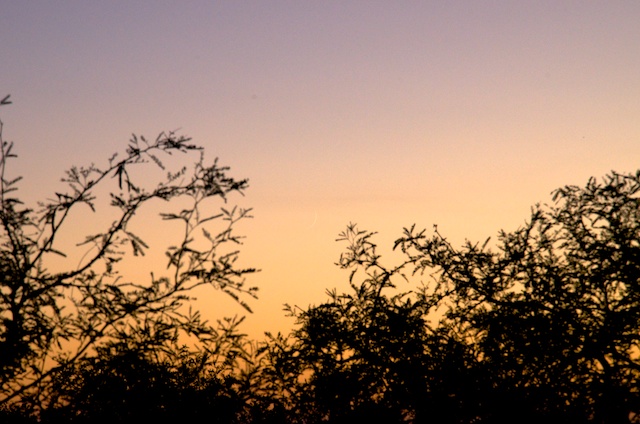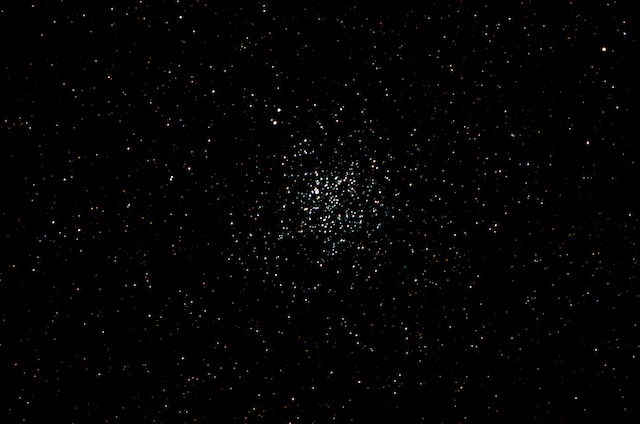
Crescent Moon, Cassiopeia, M11 Imaging;
DSO Tour
Posted: 29 September 2011![[Home!]](../../../../../etx/images/mighty_etx_logo_orig-sm.jpg)
 |
Crescent Moon, Cassiopeia, M11 Imaging;
Posted: 29 September 2011 |
![[Home!]](../../../../../etx/images/mighty_etx_logo_orig-sm.jpg) |
| Follow @mweasner | Welcome | Photos | Videos | Equipment | Links | Data |
Saturday, 24 September, I continued my troubleshooting of the Wireless AutoStar II. The keypad and the contacts all appeared OK. Perhaps just the screws holding the handcontroller needed tightening. I had noticed that it had been "flexing" more recently. After tightening the screws, it doesn't "flex". Unfortunately, clouds returned so I didn't open the observatory until Wednesday.
I opened the observatory Wednesday, 28 September, at 1810 MST, 91°F. The sky was mostly clear with a few small clouds around. At 1816 MST, viewed Venus at 77X. Tried to view Saturn but could not; too low, too faint against still bright sky 5 minutes after sunset. At 1820 MST, I did view the thin crescent moon, low in the western sky, at 77X. Took this iPhone 4 afocal image at 77X, using the MX-1 adapter:

The moon was 1 day, 20 hours, and 28 minutes old. I then took this photo of the western sky with the D7000 DSLR. The moon is in the center, below a cloud and just faintly visible as a very thin crescent:

While waiting for twilight to end, I did some more MODE key testing with the Wireless AutoStar II. It would work about every 10th time and show the MODE display when the key was pressed and held for 3 seconds. The MODE key worked normally with single quick presses for menu tree navigation. For those nights when I plan to observe objects NOT in the AutoStar database, I will have to use the wired controller. Alternatively, perhaps a HBX A-B switch box could work.
At 1900 MST, the sky was still not quite dark but I observed M13, the Great Globular Cluster in Hercules, at 77X. I then began setting up for D7000 DSLR piggyback imaging of the constellation of Cassiopeia. I began imaging at 1921 MST. Here is a 3 minute, ISO 1600, guided exposure, f/5, 50mm, slightly cropped:

The bright stars show the "M" (for "Mike") configuration. The Double Cluster is at the upper right.
Ended imaging at 1933 MST. Viewed NGC7662 (Blue Snowball); it showed nice structure at 133X and 206X. I then viewed NGC7635 (Bubble Nebula); some nebulosity was faintly visible (with averted vision) at 77X (26mm eyepiece). Using the O-III filter, nebulosity was more visible. Switched to a 2" 50mm (40X) eyepiece; no nebulosity seen. Next, viewed M31, the Great Andromeda Galaxy, with the 2" 50mm eyepiece; it was a nice view, with the M32 and M110 galaxies in the same FOV as M31.
I decided to take the "Tonight's Best" tour using the 2" 50mm eyepiece. Viewed: Double Cluster (both in the same FOV), M13 (globular cluster), M7 (open cluster), M22 (globular cluster; very nice, large), M34 (open cluster), M6 (Butterfly Cluster), M8 (Lagoon Nebula), M15 (globular cluster), M27 (Dumbbell Nebula), M2 (globular cluster), M20 (Trifid Nebula), M17 (Swan Nebula), M92 (globular cluster), M82 (galaxy), M81 (galaxy; in same FOV as M82; nice view even though very low in northern sky), M11 (Wild Duck Cluster), M5 (globular cluster), M57 (Ring Nebula), M52 (open cluster), M16 (Eagle Nebula), and M51 (Whirlpool Galaxy).
As I was ending the DSO tour, clouds were coming in from the south. Jupiter was rising over the hill to the east and was just barely visible through some clouds. At 2032 MST, viewed Comet C/2009 P1 (Garradd) with the 2" 50mm eyepiece. The MODE key worked! At 40X, the comet was nicely visible against the star field. I then went back to M11 (Wild Duck Cluster) to try to image it before the clouds covered it. Did a focus test image with Bahtinov Mask using the star Altair. Then did 10, 20, and 30 second, ISO 1600, unguided exposures of M11 with the D7000 DSLR at prime focus of the 8" LX200-ACF telescope. I just beat the clouds. This is the 10 second exposure:

At 2048 MST, the clouds were now over about half the sky and getting worse. Decided to close up. But it was a nice viewing and imaging night, although it was a short night.
The observatory was closed at 2105 MST, 73°F.
In other news, I plan to begin "modernizing" the Cassiopeia Observatory web pages. The planned changes should not dramatically affect the look of the Site although some layout changes may occur. Hopefully, I won't break anything, but if you do come across a page that has a problem, please let me know. Thanks.
Go to the previous report.
Return to the Cassiopeia Observatory Welcome Page.